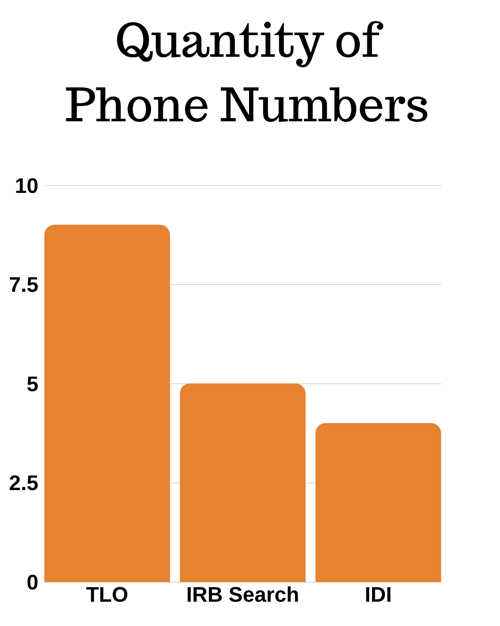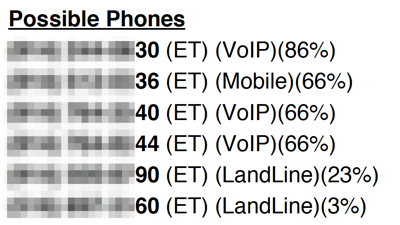Telephone numbers and address information are the lifeblood of private investigators. Getting in touch with people either by phone or in person is absolutely essential to any private investigator, regardless of his or her area of specialization.
(Note: These databases are available primarily to private investigators, so this article is a bit nerdy for the layman. Don’t say I didn’t warn you!)
One type of work that we particularly focus on is identifying potential fact witnesses for interviews.
For example, we may be asked to identify former employees who can speak about issues at a company during the relevant time. If there is a major class action fraud case, a law firm might want to identify former employees of a particular company to be fact witnesses to verify, corroborate or testify to the inner workings of a company.
Or take a major traffic accident involving a tractor trailer. A law firm may want to speak to the trucking company’s former employees who can discuss safety issues, overworked drivers, policies and procedures or a history of rules violations.
Once these former employees have been identified, we need to get in touch with them. For firms that have an endless budget or an extremely sensitive topic (i.e., sexual harassment), door-stepping, or visiting the person face-to-face, might be the best route. But in most cases, conducting interviews by phone is more cost-effective and efficient.
So in our case, where we bill by the hour, finding telephone numbers in the most efficient way possible is essential to our work.
We subscribe to a lot of databases that provide phone number information. The three that we have gravitated to the most are TLO, for its ease of use, reasonable fees and comprehensive information; IRB Search, the old reliable veteran that has been around the longest and has a deep bench of information; and IDI, which is the new kid on the block, recommended by fellow investigators for being reliable when it comes to phone numbers.
In a perfect world, we would search dozens of databases, but our time and resources (aka money) are finite resources. So which one is the best?
That’s a question we asked ourselves. To be honest, even after using all three for phone number research for years, we couldn’t come up with a reasonable answer.
So we decided to run them through the wringer.
To be perfectly honest, the results really surprised me. For the past few years, we have been using TLO as our go-to resource for identifying phone number information. But that might change now.
History Lesson
I’ve spoken to dozens of people over the years who can never understand why it’s so difficult to find a someone’s phone number.
I get it. Why does it have to be so hard? It’s especially difficult to understand if you grew up in the days of phone books, when literally every phone number in existence was in a phone book. Or you could call the operator and ask for a phone number for a name or address.
That doesn’t help much anymore.
First, phone numbers are portable. Since 2003, people have been able to transfer phone numbers to different carriers. For many years, the area code and prefix (first six digits of the phone number) told exactly which carrier the person used and where the person was located. For example, our business phone area code (914) and prefix (500) suggest that we are in New Rochelle, New York, but we are not and never have been. A few years ago, I lived in Spain, and with a VOIP carrier, and in Madrid, I was able to answer my New York-based home phone. My grandmother’s mind was blown every time I picked up the phone.
Also, the internet has spawned all kinds of ways to set up a phone number. I can install the Burner app on my cell phone and have a working number within minutes. I can text and make phone calls from literally any area code in the country and discard the number when I am done. Not only that, but there also is Caller ID spoofing, where you can indicate to the receiver of a call that the originator of the call is from somewhere other than the actual location.
Pretty nuts.
Anyway, the long and short of it is that telephone numbers are a bit of a mess.
Ground Rules
When we work with our clients, we want to make sure we have confirmed phone numbers. And by confirmed, I mean that the person I am trying to reach is going to answer the phone. Just because a database says that a phone number is associated with a person doesn’t make it so. Most databases will give you a plethora of phone numbers that have been associated with a person.
But not all of them work. They might be disconnected, old or transferred to a new person. Or it just might be an old number associated with another family member.
Either way, the only way to confirm the phone number is to call it and ask for the person or confirm he or she is on the outgoing voicemail system.
So we took 52 phone numbers we had confirmed, ran them through all three databases, and figured out which one came out on top.
Reliability
TLO, IRB Search and IDI all display phone numbers in a list. TLO has a nice feature in which they indicate the “likelihood” that the number was current, assigning each phone number a percentage of likelihood. They must have some type of algorithm that figures that out. They also indicate whether or not the phone is a mobile, land-line or VoIPor phone number. In either case, it’s not always that accurate, but it doesn’t hurt. In general, it’s relatively accurate, as numbers with a low percentage of likelihood are typically old numbers. But having conducted hundreds of phone interviews, I can tell you it’s not perfect.
Neither IRB Search nor IDI has that feature, but it’s presumed that the ones listed toward the top are the freshest, most recent ones.
In this category, IDI was the winner. On average, the correct phone number was the first phone number on the list 71 percent of the time, while TLO was first 42 percent of the time and IRB Search was first 34 percent of the time.
If we expanded this reliability test to the first or second number on the list, IDI had the correct number 85 percent of the time and TLO was right 67 percent of the time, while IRB was right on the list 54 percent of the time.
Accuracy
Now we get to the heart of the matter. After all, getting the most accurate information is obviously the most important. As I mentioned above, we had verified working numbers of all 52 people. So which one of them had the most accurate numbers?
TLO had 50 of 52 (96 percent), IDI had 46 of 52 (88 percent) and IRB Search had 37 of 52 numbers right (71 percent).
TLO was the winner here, with almost all the numbers correct, and IDI was not far behind. IRB Search was a distant third.
Cost
I would be remiss if I did not mention the cost. IRB Search cost $3 per search ($156 total for 52 searches) and TLO cost $1.80 per search ($90 total), while IDI cost $0.50 per search ($25.50 total).
IDI was the hands-down winner here. In my mind, cost should never be the determining factor; getting the best information is far more important. But considering IDI cost less than a third of TLO and six times less than IRB Search, it’s certainly a factor.
A Personal Test
So we had a total of 52 phone number to verify, 50 of which came from previous cases that we worked on. But I also tested this out on myself and my colleague to see whether they had our personal cell phone numbers. All three databases had my colleague’s personal cell phone number. TLO and IDI had my personal cell phone and home number listed prominently at the top; IRB Search had my home number but not my cell phone number.
The Winner?
If you are keeping score at home, both TLO and IDI won two of the categories and finished second in two of the categories, while IRB Search finished last in all four categories.
As I mentioned above, TLO has been our go-to source. Personally, I like the way the search functionality works and how easy it is to use. IDI is still pretty new to us, but given these results, it certainly deserves a closer look. IRB was the clear loser here, having the least reliable information and being the most expensive.
Keep in mind that this is a pretty small sample size. I am no mathematician, but 50 phone numbers out of billions of records doesn’t really provide a great sample size.
I’m not trading in my subscriptions for any of them. They all deserve a look, and I will continue to use all three when necessary. One of my many mottos in this business is to use multiple sources for research. Because you never know which one may help you. But this test may help us decide in the future which one to prioritize.
Also, keep in mind that these databases also provide dozens of other data points, including address history and (limited) criminal history as well as hoards of other information. So while they may be great at one thing, they may not be so great at another.
But that’s a blog post for another day.







